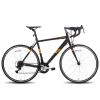Cycle Care
Checking Tire Pressure of Cycle
Checking the tire pressure of your bike is essential for maintaining a smooth and safe ride. Proper tire pressure helps prevent flats, improves comfort, enhances traction, and optimizes performance. Here’s a step-by-step guide to checking your bike’s tire pressure:
What You’ll Need:
- A tire pressure gauge (digital or manual)
- A pump (with a pressure gauge built-in, if possible)
- Knowledge of the recommended pressure for your bike tires (usually marked on the side of the tire)
Step-by-Step Guide:
1. Find the Recommended Tire Pressure
- Look on the sidewall of your bike tire. It should be printed in PSI (pounds per square inch) or Bar (1 bar = 14.5 PSI).
- Most road bikes will have a pressure range of 80–130 PSI, while mountain bikes typically run between 30–50 PSI, and hybrid or commuter bikes may fall in between (50–70 PSI).
- The tire pressure is usually expressed as a range (e.g., 50-70 PSI), so you can adjust based on your weight, riding style, and terrain. For a smoother ride, go toward the lower end of the range; for better performance and less rolling resistance, go toward the higher end.
2. Remove the Valve Cap
- Unscrew the valve cap from the valve stem. Keep it in a safe place so you don’t lose it. If you have a Presta valve (thin valve), make sure to unscrew the small nut at the top to open it for inflation.
3. Check the Tire Pressure
- Using a Tire Pressure Gauge:
- Attach the pressure gauge to the valve stem (there are two types of valve stems: Presta and Schrader).
- Press firmly until the gauge gives you a reading. For Schrader valves (the same as car tires), just push the gauge down onto the valve. For Presta valves, you may need to first unscrew the valve and then press the gauge on.
- Read the pressure on the gauge and compare it to the recommended PSI on your tire.
- Using a Pump with a Built-in Gauge:
- Attach the pump to the valve stem (same process as with the gauge, but you may need to hold it steady while you check).
- The pump will display the pressure as you inflate or deflate. If the pressure is already within the recommended range, you don’t need to add or remove air.
4. Inflate or Deflate as Needed
- If the pressure is too low, use a pump to add air to the tire:
- Attach the pump to the valve.
- Begin pumping until you reach the recommended PSI.
- Keep checking the pressure with your gauge as you pump to avoid overinflating.
- If the pressure is too high, you can release air by pressing the small metal pin inside the valve (for Schrader valves) or by gently unscrewing the Presta valve nut and letting air out. Use a gauge to monitor as you adjust the pressure.
5. Recheck the Pressure
- After inflating or deflating, recheck the pressure with your gauge to make sure you’ve reached the recommended PSI.
6. Replace the Valve Cap
- Once the pressure is correct, screw the valve cap back on to protect the valve from dirt and moisture.
Tips for Proper Tire Pressure:
- Check Regularly: It’s a good idea to check your tire pressure before every ride. Tires can lose air over time, and under-inflated tires can cause flats and poor performance, while over-inflated tires can make for a harsher, less comfortable ride.
- Avoid Over-Inflating: Over-inflating tires can lead to a rougher ride, reduced traction, and an increased risk of a blowout.
- Adjust for Conditions: For a smoother ride or more grip on rough terrain, lower the pressure a bit. For better performance on smooth roads, increase the pressure.
- Use the Right Pump: Make sure the pump you’re using is compatible with the type of valve on your bike (Presta or Schrader).
By regularly checking and maintaining the correct tire pressure, you’ll enjoy a safer, smoother, and more efficient ride.






